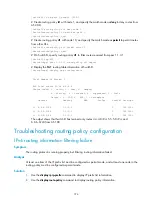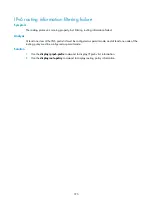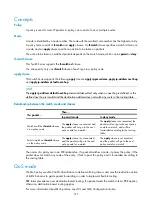
380
Step Command
Remarks
3.
Configure interface PBR
based on a policy.
ip policy-based-route
policy-name
Not configured by default.
NOTE:
If the specified policy does not exist, the interface PBR configuration succeeds, but it takes effect only when
the policy is created.
PBR and track
Associated with a Track object, PBR can sense topology changes faster. You can associate PBR with a
track entry when configuring the outgoing interface, default outgoing interface, next hop, and default
next hop to dynamically determine link reachability. The PBR configuration takes effect when the status of
the associated Track object is
Positive
or
Invalid
.
For more information about track-PBR collaboration, see
High Availability Configuration Guide
.
Configuring PBR (using a QoS policy)
Before you configure PBR, complete the following tasks:
•
Configure a QoS policy by configuring the match criteria and a redirection action for PBR.
•
Apply the QoS policy by defining the occasion to which the PBR applies.
Configuring a QoS policy
To configure a QoS policy:
Step Command
Remarks
1.
Enter system view.
system-view
N/A
2.
Create a class and enter
class view.
traffic classifier
tcl-name
[
operator
{
and
|
or
} ]
N/A
3.
Configure the match
criteria.
if-match
match-criteria
N/A
4.
Exit class view.
quit
N/A
5.
Create a behavior and
enter behavior view.
traffic behavior
behavior-name
N/A
6.
Configure a traffic
redirection action.
redirect next-hop
{
ipv4-add1
[
ipv4-add2
] |
ipv6-add1
[
interface-type
interface-number
] [
ipv6-add2
[
interface-type interface-number
] ] }
[
fail-action
{
discard
|
forward
} ]
Optional.
The default option for the
fail-action
is
forward
.
7.
Exit behavior view.
quit
N/A
8.
Create a policy and enter
policy view.
qos policy
policy-name
N/A
9.
Associate the class with
the traffic behavior in the
QoS policy.
classifier
tcl-name
behavior
behavior-name
N/A






























